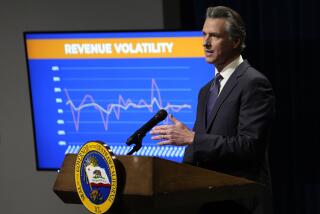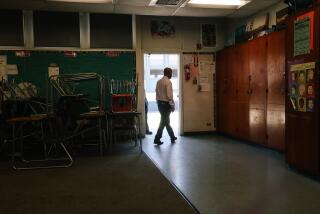Half of Windfall Was Already Owed to Schools
- Share via
SACRAMENTO — Nearly half the $2.2 billion in new state aid to education that Gov. Pete Wilson has trumpeted during the past week is actually money that schools already were entitled to but did not receive because of miscalculations made by the state Department of Finance, officials said Friday.
In releasing his revised budget proposal Wednesday, Wilson proclaimed that California’s schools, which long have trailed the nation in per-student spending, will be “catching up with a vengeance” because of his proposed budget for the fiscal year starting in July.
Wilson noted that of all the new revenue flowing into state coffers as a result of the strengthening economy, 98% would be going to schools. Lawmakers and education advocates lauded the governor’s school funding plan as a reaffirmation of the state’s commitment to public education.
But in fact, much of the money is actually payback of funds that should have been given to the schools starting in the 1995-96 fiscal year. Mistaken estimates of California’s population and school attendance by the administration’s accountants allowed the state to hold the money back from the schools.
The incorrect population estimates mean that schools were shortchanged by a total of $576 million since the 1995-96 fiscal year: $108 million in 1995-96, $223 million in the current year and $245 million for the budget year beginning in July.
State officials insist that the estimates were made in good faith. Others voice some doubts.
In addition to the mistaken population estimates, the finance department’s initial estimates of school attendance would have shortchanged schools in the fiscal year that starts in July by an additional $443 million.
Now, with the state enjoying an influx of new funds, that money--and more--will be returned to the schools.
“Nothing was mistakenly withheld--period,” said H.D. Palmer, spokesman for the Department of Finance. “Let’s make that very clear. What we do, as you go through the year, at different points you get more data, from a litany of sources. . . . We take all of that most recent data that we’ve got and put that into” the school funding calculations.
Palmer and others point out that since the only accurate count of population comes once every 10 years at the census, all annual population counts are estimates.
Still, by freeing up funds to be used elsewhere, the miscalculations did make it easier for Wilson and the Legislature to balance the budgets during more difficult economic times in 1995-96 and 1996-97, public school advocates note.
“One could only speculate that the healthier economy is an opportunity to make up for shortchanging schools in the past,” said Sen. Jack O’Connell (D-Santa Barbara), chairman of the state Senate budget subcommittee on education.
O’Connell added, however, that he “would give them the benefit of the doubt.”
Others are somewhat more suspicious.
“The errors should be random. But they weren’t,” said John Mockler, lobbyist for the Los Angeles Unified School District, referring to the Department of Finance’s estimates of state population and school attendance. Those errors consistently were on the side of reducing the flow of funds to schools, he noted. “It raises your concern level.”
Despite that, “you’ve got to respect [the Department of Finance]. They rectified the numbers. They’re moving in the right direction,” he said.
In Orange County as elsewhere in California, school budgets have been pinched until recently. Educators here lamented news that they might have missed out in past years on cash infusions from the state.
“Just as we are obligated to have the necessary checks and balances in our system, obviously the same mechanism is needed within the state government so that errors like this don’t occur again, because kids do suffer,” said Al Mijares, superintendent of Santa Ana Unified School District, the county’s largest.
Martha Fluor, president of the board of trustees of the 19,000-student Newport-Mesa Unified School District, criticized a state education funding system that pumps wildly varying amounts of money into schools from year to year.
“Now that the economy is recovering from recession, our children seem to be able to benefit,” Fluor said. “But when the economy of California suffers, do the children necessarily have to suffer for it? I think that’s totally unfair.”
In the budget year beginning in July, schools stand to receive $32 billion in state aid, the result of several aspects of the state’s complex school-aid formula that have converged in an extraordinary way to dictate that nearly all of the state’s revenue windfall must be earmarked for education.
Proposition 98, passed by voters in 1988, guarantees schools at least 40% of the state’s general fund budget. When the state gets an increase in revenue, schools generally receive 60% of the increased money.
The exact amount is determined by a variety of factors, among them state revenue, school attendance and per capita income.
Per capita income is determined by dividing total income of the state’s residents by the number of people living in California, making accurate population estimates a vital aspect of the formula.
In recent years, the Department of Finance has overestimated the state’s population. That, in turn, has reduced the department’s calculation of per capita income and lowered the amount of money sent to the schools.
Demographers in the state Department of Finance and the legislative analyst’s office base their estimates on several sources, including births and deaths, and guesses of the number of people coming to California from other countries and states and the number moving out of the state.
Finance initially calculated that 100,000 people had left the state in 1996. Later data from the Department of Motor Vehicles and other sources showed the number was closer to 300,000.
Under the school funding formula, such small differences affected large amounts of money.
“We sound like we’re whiny little technocrats, but these little changes mean big differences. It matters,” Mockler said.
Mockler has been raising the issue of the Department of Finance’s population estimates for several years. But it wasn’t until the legislative analyst’s office raised similar concerns that the Wilson administration responded by updating its population estimate, essentially agreeing with the office’s conclusions.
The discovery that schools would be receiving 98% of all the state’s new revenue this year illustrates how the school funding formula restricts state budget writers and took by surprise even the most ardent education supporters.
Senate President Pro Tem Bill Lockyer (D-Hayward), for one, said he would support giving schools even more money.
“Because of the years of neglect and underfinancing, they’re entitled to some time to try to catch up,” said Lockyer, a former schoolteacher and school board member.
But he added: “We do have other needs--to help cities and counties, to fund health care and higher education and some of the welfare reform proposals. There is not a lot of room within that 2% for expansion of any other program.”
Also contributing to this report was Times staff writer Nick Anderson.
More to Read
Sign up for Essential California
The most important California stories and recommendations in your inbox every morning.
You may occasionally receive promotional content from the Los Angeles Times.










